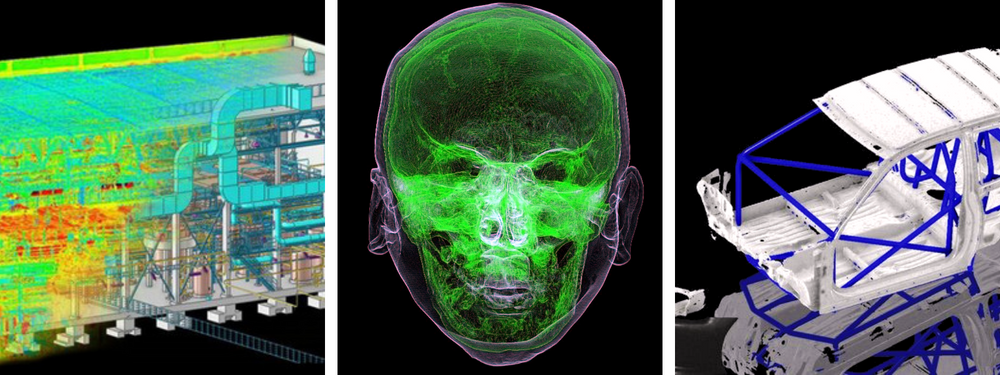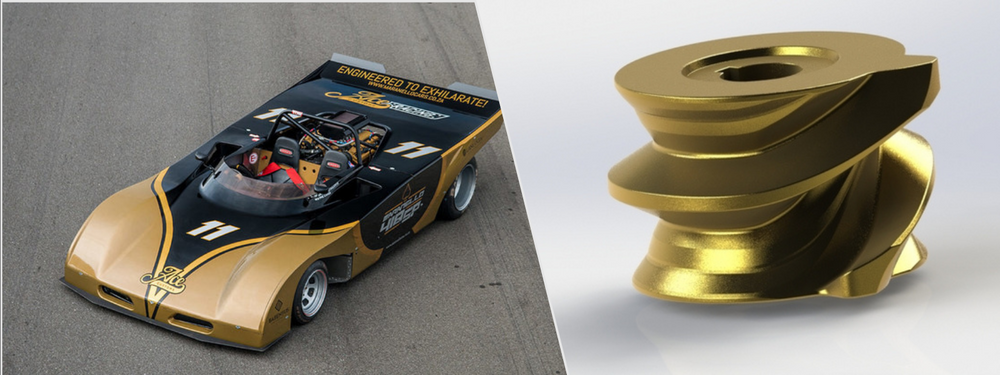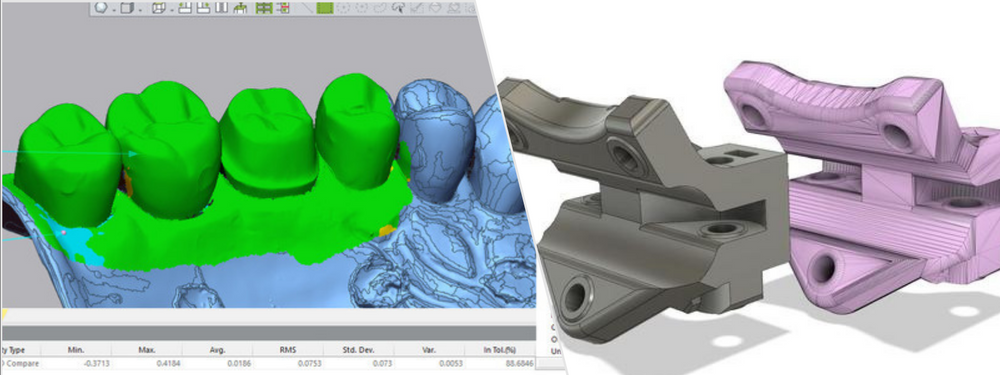3D scanners are dead-accurate measurement tools. Laser triangulation and structured light are the most used techniques for various applications.
Laser triangulation
A laser triangulation scanner is designed to be used on non-living objects and projects millions of lines or points on an object and then captures the reflection with sensors. The 3D scanner accurately measures the object by calculating the distance between the laser source and the projected points; the reflection angle is also considered.
Each of the millions of points directed to the object has its distance measurement. The calculation is accurate to micrometers (1 millimeter consists of 1000 micrometers). Based on the generated data, the scanner can map the object’s surface and draw an identical shape.
Laser triangulation technology is not typically found in portable 3D scanners, and the scanning range is limited to several meters. Thankfully, it can scan moving objects without losing accuracy. Another downside is that laser triangulation may have difficulties generating precise shapes when the surface area is transparent or shiny. 3D laser scanners can also cause damage to the eyes and thus should not be applied to humans and animals.
Structured light
For scanning people and animals, structured light is the technology of choice. Many consumer- and professional-grade portable and stationary 3D scanners are on the market. Structured light also uses triangulation but projects patterns of light (instead of laser) onto the objects. The designs are projected from one specific point at a time, so it may take several scans to map the object’s surface entirely.
Depending on the object size, you may have to do a dozen scans to get accurate measurements. If a small action figure requires four or five scans, a pair of shoes will probably need twice as many scans. Data from each scan is then combined to form a 360-degree shape. Mounting the object on a motorized turntable makes for a practical workaround.
Structured light technology can only scan a static object. For instance, you can easily scan a rock, but a playful cat requires patience. Most consumer-grade 3D scanners are structured light and work best on small objects and from close range. However, few devices can scan large objects from a distance, but they are in the high-end category.
3D scanner output
More advanced scanners deliver a greater level of detail and a higher degree of accuracy than others. 3D scanners capture only the object’s shape regardless of the technology used. The image generated from the scanning process comprises mesh data or point clouds, which work as a single entity. In other words, you cannot edit them as if they are CAD files.
Before turning the image into an editable CAD, it must be first converted to a workable format through a process known as Scan to CAD. You can do this automatically using CAD design software plugins (most are paid) or converting the image with an online service for a fee.

3D scanning applications
3D scanning is the next level of digitization, and 3D scanning services are available for businesses that need help. In essence, technology transforms physical objects into digital images. However, it is unlike conventional photo or document scanning because the resulting data can be converted into an editable CAD file. With that ability comes various applications across the engineering and manufacturing industries.
Reverse engineering
It is impossible to talk about 3D scanning without mentioning reverse engineering. As the name says, the process deconstructs an existing product to determine how it works. Every detail is scrutinized, including the materials, structure, geometry, mechanism, power delivery, and overall engineering design. The purpose is to replicate the same product or develop an improved version, and reverse engineering reveals the design intent of the maker.
Many companies find it a common practice to reverse-engineer their competitors’ products to be used as points of reference when designing an alternative. Creating something based on an existing product is easier than from a blank slate.
When the original CAD drawing of a product or design is unavailable or inaccessible, 3D scanning opens the doors to a thorough overview of the object in question. In addition to superficial details, such as dimension and general specification, the scan result can be converted into a CAD file for construction and engineering analysis.
Quality control
Accurate measurement, regardless of form factors, makes 3D scanning a reliable tool for quality inspection. Comparing the original CAD drawing and the scanned file should show any dimension discrepancies and aesthetic inconsistencies. Factories turn to 3D scanners for quick quality control and to determine whether the final product falls within the predetermined manufacturing tolerance. Scanning may also reveal defects before the product arrives in the factories.
Robotic Guidance
3D scanners are essential in vision-guided robotics (VGR) applications in a factory setting, and they provide visual information to control robotic motion. Among the most common functions include the following:
Quality assurance is completed by comparing manufactured goods against the CAD model.
Pick and place (open loop system) by identifying specific parts without human input. Robotic arms can also automatically move the selected parts to another position in the assembly line.
Closed loop system in which the robotic action must send feedback to the computer controller. Verifying a completed action may require a 3D scanner to determine whether or not the manufactured product meets the pre-specified standard. Sensors with 3D scanners allow automatic modification to command control each time the robot reacts to changes in its workspace.
Only about 35% of factory robots in the United States use an open-loop system for 3D scanning. A closed-loop system offers greater flexibility in complex manufacturing tasks but requires more capital investment and high maintenance requirements.

Architectural Heritage Preservation
CAD models of large buildings are necessary for documentation, restoration, or renovation projects. When the architectural designs, style and details of an old building must be restored to their original specifications, 3D scanning provides an easy way to draw the CAD plan. Scanning the entire building is easier than measuring every window, façade, beam, and ornament. Laser triangulation is better than structured light for the purpose. Some 3D laser scanners can cover an area as large as 350 meters radius with only a single scan. The device can scan towers or rooftops from an aerial vehicle.
Archeology
Structured light 3D scanners are especially effective in digitizing physical artifacts, including fossils, because the process makes no contact with the actual objects. Archeological studies and museums can share detailed images of historical relics with the world without risking damage to the original. 3D scanners make digital representations identical to authentic artifacts and true-to-scale.
Additive printing
One of the standard applications for consumer 3D scanners is additive manufacturing or 3D printing, which is also used for rapid prototyping. Scanning turns a physical object into a digital format, and you can use the file (after conversion to STL, a format understood by 3D printers) to recreate the same shape. 3D printers are limited in the type of materials they can use, but scanning is quicker than creating the model from scratch.
Medical industry
Customized healthcare products such as prostheses, braces, and personalized wheelchairs are built to a specification based on the users’ necessities. Medical professionals use 3D scanners to collect patients’ body measurement data, and accurate measurement ensures that custom products make a perfect fit to increase comfort or reduce pain.
Garment design
A full-body 3D scanner allows for accurate custom garment design production. A pair of shoes can be made to fit the buyer’s feet. One of the pre-manufactured sizes could fit well, but 3D scanning ensures that the shape and comfort are built to cater to the buyer’s specifications. It is not just about the size but human body anatomy for ergonomics.
Films and Games
The entertainment industry can build digital models of every living organism using 3D scanners and create films and games. Once again, it is easier and quicker to develop 3D scanning assets by scanning than drawing them from scratch. 3D artists can manipulate digital objects using CGI and transform them into any shape and color imaginable, and they can also scan landscapes and modify the images for games and movies.

Forensics
A 3D scanner mounted on a drone combined with conventional cameras provides a good vantage point for investigators to understand and record crime scene evidence. The scanned image can help investigators better understand the event sequence leading up to the incident. Once converted into CAD format, investigators can comprehensively reconstruct the crime in a digital environment and visualize possible scenarios to test different theories.
Logical Step after CAD
In 2020, the 3D scanning market was valued at $1.4 billion and was expected to grow to $4.7 billion in the next five years. According to Global Market Insights, the market can surpass $7.5 billion in 2027. Considering how 3D scanners offer promising improvements to a wide range of industries, including fashion, archeology, forensics, and games, it is not an exaggeration to say that 3D scanners are the next step after the arrival of CAD. Fortunately, there are 3D scanning services available to help companies find freelance 3D scanning service experts for their needs.
How Cad Crowd can assist
Cad Crowd proudly partners with a wide array of exceptional freelance 3d scanning and design freelancers to deliver top-notch results. For inventive and tailored 3D scanning solutions, confidently move forward in your project’s journey.
Reach out to us for a free quote today, and let our freelance 3d scanning services turn your vision into reality.
